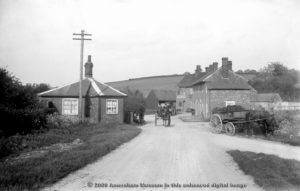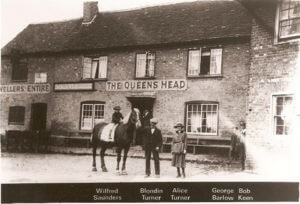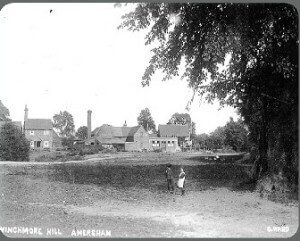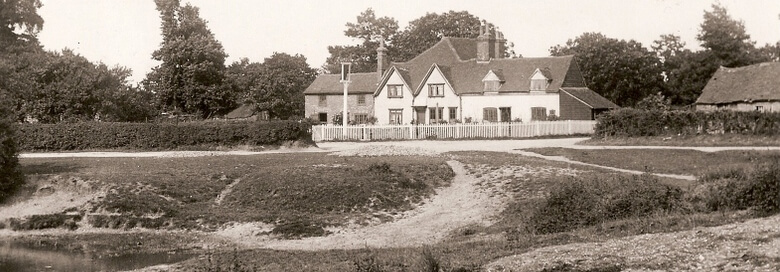The Pubs of Winchmore Hill
This article was written by Stephen Palmer.
For most of the 19th and 20th centuries there were four pubs in or near to Winchmore Hill, and their names reflect local features or historic circumstances. We are fortunate to still have two pubs in the village in operation.
The Queens Head

Standing on the corner of Whielden Lane and the Amersham to Wycombe road, The Queens Head used to be the oldest pub in the village. Originally known as The Red Lion, the farmhouse probably became a beerhouse when the road between Reading and Hatfield , via Amersham and High Wycombe, was turnpiked in 1767. In his will of 1773, Thomas Child of Coleshill bequeathed the property to his brother William Child, with Thomas Archer being the tenant
 In 1802 the beerhouse was sold by the six children of William Child to Wellers, Brewers of Amersham, who retained ownership for 127 years. Four cottages to the right of the Queens Head were built about 1816 by Charles Axten, but in 1855 they were also sold to the Weller family.
In 1802 the beerhouse was sold by the six children of William Child to Wellers, Brewers of Amersham, who retained ownership for 127 years. Four cottages to the right of the Queens Head were built about 1816 by Charles Axten, but in 1855 they were also sold to the Weller family.
The Weller family had built up a local chain of about 130 pubs, but the whole business was put up for sale in September 1929 – the Queens Head and adjacent cottages being Lot 76. The whole business was purchased by Benskins of Watford, who were in turn taken over by Allied Breweries in 1979. The Queens Head had a considerable reputation amongst the local farming and hunting community, but it closed in 1999 and is now a well-appointed private house.
The Lord Nelson
 The Lord Nelson stood further up Whielden Lane on a corner of the Winchmore Hill Common. Land was allocated to Thomas Bovingdon of Glory Farm under the Amersham Enclosure Act of 1815, with of course the battle of Trafalgar still in recent memory. The first licensee of the pub was William Blackwell, and throughout the 19thcentury various licensees are listed in Trade Directories and census-returns. Wellers Brewery purchased the pub in 1871, with William Beeson being the landlord from 1870 to 1899, followed by Thomas Payne who was landlord for over 30 years.
The Lord Nelson stood further up Whielden Lane on a corner of the Winchmore Hill Common. Land was allocated to Thomas Bovingdon of Glory Farm under the Amersham Enclosure Act of 1815, with of course the battle of Trafalgar still in recent memory. The first licensee of the pub was William Blackwell, and throughout the 19thcentury various licensees are listed in Trade Directories and census-returns. Wellers Brewery purchased the pub in 1871, with William Beeson being the landlord from 1870 to 1899, followed by Thomas Payne who was landlord for over 30 years.
The property was sold in 1929 by Wellers Brewery to Benskins, and they kept the pub in operation until the late 1950s. The building had changed very little since its original construction, but it was demolished in 1960, following which a row of houses called ‘Nelson Close’ was built… thus perpetuating for more than 200 years the memory of Lord Nelson and the historic sea-battle.
The Plough
 The Plough was originally an old farmstead, with the grass area in front allotted to the Rogers family as part of the Amersham Enclosure Act of 1815. (The original wooden framework of the building, with its inglenook fireplace and paved passage behind leading to the kitchen and pantry can still be seen) The Plough was granted a beerhouse license in 1830, with the beerseller, Caroline Rogers, supplementing her income by selling groceries
The Plough was originally an old farmstead, with the grass area in front allotted to the Rogers family as part of the Amersham Enclosure Act of 1815. (The original wooden framework of the building, with its inglenook fireplace and paved passage behind leading to the kitchen and pantry can still be seen) The Plough was granted a beerhouse license in 1830, with the beerseller, Caroline Rogers, supplementing her income by selling groceries

Wellers Brewery purchased The Plough in about 1870, and it was probably about this time when the wings to the left and right of the original building were constructed. The new tenant George Pursey supplemented his income by manufacturing chairs, with a turning shop and a timber-yard and saw-pit immediately behind the building. George Pursey died in 1911, but was succeeded as landlord by his son Thomas. Thomas died in 1919, with the tenancy taken over by his widow, Emma Pursey. Her son, Frank, continued as landlord until 1961, so the same family held tenancy for 90 years.
The Plough was included in Weller’s sale of their entire chain in 1929, and over the last 50 years there have been a variety of tenants, including the well-known actress Barbara Windsor. In 2003 there was a plan to convert the Plough into a number of flats, but this met with vigorous local opposition and the proposal was withdrawn. Fortunately The Plough continues as a popular local pub overlooking the Common and with a substantial Italian restaurant.
The Potters Arms

Clay deposits found in the Winchmore Hill/ Coleshill area are highly suitable for the production of pots, tiles and bricks, and in the 18th century there were a number of local pottery kilns. One of these was established in about 1770, overlooking the Winchmore Hill Common, and this flourished throughout the 19th century producing a variety of flower-pots and domestic earthenware. The Potters Arms stood adjacent to the kiln, on land owned for many years by the Bovingdon family of Glory Farm, further down Fagnall Lane.
 The property was bought in 1782 by Benjamin Walker, whose heirs were awarded two further small allotments of land under the Amersham Enclosure act of 1815. Previously known as ‘Sansuns’, by 1830 the Potter Arms is recorded as holding a beerhouse license. Regular census returns and directories show various owners and tenants throughout the 19th century, often as both beer retailer and potter. The leaseholder in the 1870s was Wheeler’s Brewery of High Wycombe, but shortly after 1887 the freehold of the pub was purchased by William Hobbs.
The property was bought in 1782 by Benjamin Walker, whose heirs were awarded two further small allotments of land under the Amersham Enclosure act of 1815. Previously known as ‘Sansuns’, by 1830 the Potter Arms is recorded as holding a beerhouse license. Regular census returns and directories show various owners and tenants throughout the 19th century, often as both beer retailer and potter. The leaseholder in the 1870s was Wheeler’s Brewery of High Wycombe, but shortly after 1887 the freehold of the pub was purchased by William Hobbs.
Joseph Hobbs was the last potter to work at Winchmore Hill, with his widow still running the pub in 1920. The pottery next door was closed and demolished in 1932, but the pub continues in operation to this day, well-supported for “Comedy Nights” and other attractions.

